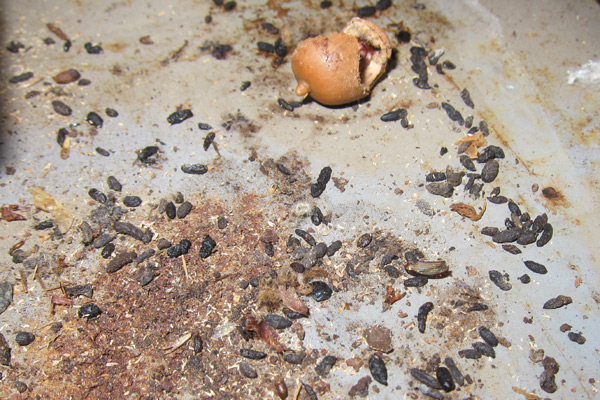Have you ever wondered what mouse feces look like and where it could be found? When you hear about mouse feces
or droppings, naturally you might get uneasy. Depending on where they are found, you might actually feel nauseated,
especially considering the fact that the mouse itself is not a welcome animal around humans let alone having its droppings
within your immediate vicinity.

Some of you might not have set eyes on mouse droppings before and might be wondering how it looks. Well, wonder no further because if
you have seen a grain of rice, then you should have a very fair idea of what mouse feces look like. Yes, I said a grain of rice.
To effectively manage the problem of a rodent infestation, first you have to know what mice feces look like so you will know where the
animals are and perhaps how many you are dealing with.
If you see them in an enclosed area where you store uncooked groceries or where you keep your waste, then you should be more thorough in
managing both food and disposables. Based on research, mouse droppings and urine are said to be responsible for the cause and spread of
Lassa fever, in some parts of West Africa in particular, as well as other diseases, and therefore the waste should be handled carefully.
A mouse dropping is oval, and the grain of rice comparison should give you a clearer view of what the mouse feces look like. It is usually
between 3 to 16mm in length and comes in varying shades of black, gray and brown. When recently dropped by the mouse, it comes out quite
soft and is shiny black in appearance.

At this state it could be quite sticky and contagious if touched with the bare hands. When it has stayed for a longer period, say four days to
a week, it changes from shiny black to a brownish shade and then gray after a week. At this stage, it will disintegrate when touched. The mouse
usually releases between 50 – 75 pellets of poop in a single day; with this information you can have a fair idea of the level of the infestation.
Also, it is possible that you are dealing with more than one mouse in this case.
There are several places you can find mouse feces apart from waste disposal sites and food storage areas, which includes rundown buildings, attics
and abandoned basements, toilet facilities and more.
Mouse feces can be spotted around where they eat or live, and then they can continue defecating while they walk; this can help you track its movement.
If you are familiar with its feces, you can identify the infestation from the way the environment smells because it usually leaves an offensive odor.
Ensure that you clean out the entire area where the feces are found. Maintain the area properly by using water, soap, and disinfectant to avoid diseases
and other ailments.
Also, ensure all containers and food related materials are kept tightly covered and dispose of waste properly or put it in a well-sealed bag if you are not ready to dispose of it.
Go back to the
How to get rid of mice in the attic home page. You might also want to read about
how to kill mice and why the use
of snap traps is better than
mouse poison. Read an analysis of the different types of traps and how to use them on the
how to trap mice page.
Learn why
bait is not as important as trap type, placement and location. Also read a full analysis of
mouse repellent to understand why it
never works. If you see droppings and want to identify them, read the
mouse poop page. If you need to hire professional help, read about
how much does mouse removal cost?
or you can read this site to learn how to do it yourself. Feel free to email me about MOUSE FECES